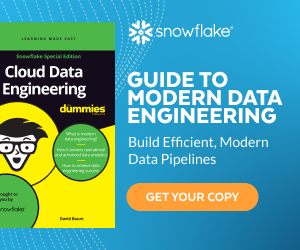Optimizing Streaming data ingestion for better streaming analytics
Streaming data is generated continuously from a variety of sources, including IoT sensors, financial transactions and log files. To be actionable, this data must be processed and made available as it is created. In this article, we’ll explain how a streaming data platform's capabilities support near real-time data ingestion. We’ll also provide an overview of Snowpipe Streaming and share how its unique features can help organizations optimize streaming data ingestion and analytics.
How streaming data platforms optimize data ingestion
Behind every streaming data analytics solution is a data platform with the resources and features required to build, use and maintain real-time data pipelines. Here are the key capabilities of a streaming data platform.
Reliable processing for real-time data pipeline
By nature, streaming data is dynamic, making it impossible to accurately predict how much data will be generated and what compute resources will be required to process it. Streaming data platforms automatically scale, providing the compute required as needed to handle the intensive and fluctuating resource demands inherent in streaming data applications.
Reduced architectural complexity
Streaming data processing requires a specialized data architecture to ingest, analyze, transform and store data, and then output results. Building the architecture needed to support streaming data workloads from the ground up can consume significant time and resources. Streaming data platforms are designed to minimize this complexity, providing an expansive set of capabilities for creating performant, scalable and reliable streaming data pipelines.
Built-in data governance and security
Data streams are constantly evolving to fit the needs of modern businesses, making it challenging to balance efficiency and security. Streaming data platforms enable comprehensive data governance for data in motion and at rest, providing organizations with the tools required to effectively manage the availability, usability, integrity and security of their data. Standards-based data security practices based on a multilayered security architecture help protect streaming data.
Usage-based pricing
Usage-based pricing ensures organizations only pay for the resources they consume, with automatic, elastically scalable compute and storage resources ready when needed. This pricing model is valuable for any data workload, but is especially important for streaming data ingestion due to the massive amounts of data involved.
Snowpipe Streaming: Advanced features for streaming data
Snowpipe Streaming offers advanced features for building more efficient and effective streaming analytics solutions. Here are five ways Snowflake Streaming can help your organization optimize your streaming data ingestion and analytics.
Unite streaming and historical data
Real-time data is valuable, but pairing it with historical data provides additional context. Combining streaming and historical data can be a challenge for data engineering teams if they need to manage separate infrastructure for batch data and streaming data. Snowpipe Streaming eliminates infrastructure management complexity.
Ingest data directly into Snowflake
Rather than streaming data from its source into cloud object stores and then copying it to Snowflake, data is ingested directly into a Snowflake table to reduce architectural complexity and end-to-end latency. This native streaming data ingestion simplifies the creation of streaming data pipelines with sub five-second median latencies, ordered insertions of rows and serverless scalability to support throughputs of gigabytes per second. With Snowpipe Streaming, data engineers and developers no longer need to stitch together different systems and tools to work with real-time streaming and batch data in a single system.
Prepare and transform data using the language of your choice
Snowflake enables developers to write code using the language of their choice, including Python, Java and Scala, and run that code directly in Snowflake. Snowpark gives developers the option to expand beyond Snowflake’s original SQL development interface, allowing them to prepare and transform their data directly in Snowflake with securely shareable results.
Access to Snowflake’s elastic storage and compute resources
Snowflake is a fully managed service, providing and managing compute resources, automatically growing or shrinking capacity based on the current Snowpipe load. With access to Snowflake’s unique multi-cluster shared data architecture, organizations can tap into the performance, scale, elasticity and concurrency required for powering even the most complex, resource-intensive streaming data analytics use cases.
Snowflake Streaming + Snowflake Connector for Kafka
Using Snowpipe Streaming in your data loading chain from Kafka results in lower load latencies, with corresponding lower costs for loading similar volumes of data. Whether you opt to use Snowpipe Streaming as a stand-alone client or as part of a Kafka architecture, you can create scalable and reliable data pipelines with built-in observability in a fully managed underlying infrastructure.
The future of streaming data is Snowflake
The Snowflake Data Cloud has a wide range of deeply integrated components to help you build modern streaming data pipelines. With Snowpipe Streaming, organizations can leverage superior performance, functionality and cost-efficiency, helping them remain agile and competitive in a dynamic business landscape.
Learn more about Snowflake and streaming in our webinar "Top Streaming Data Analytics Reference Architectures".
